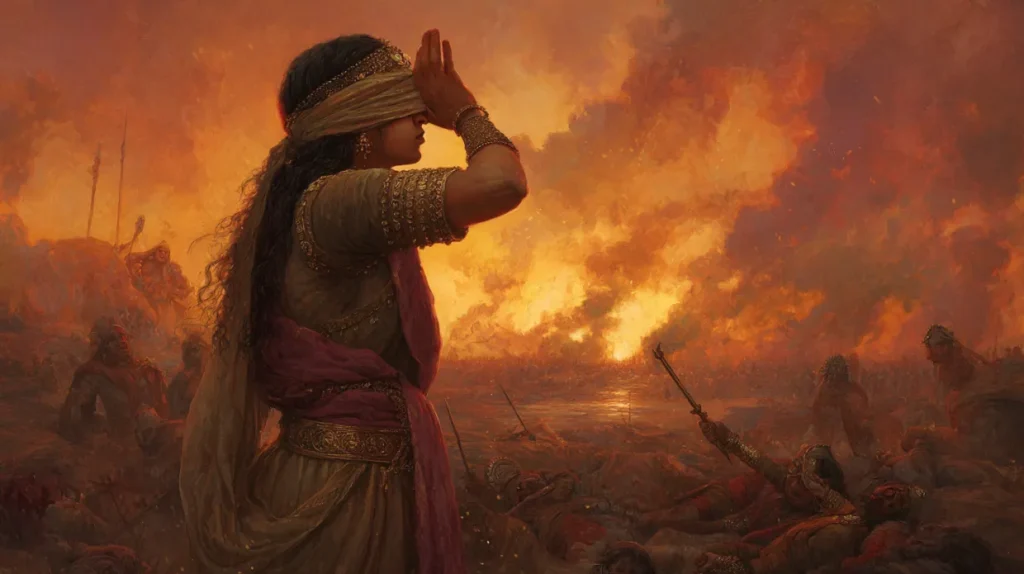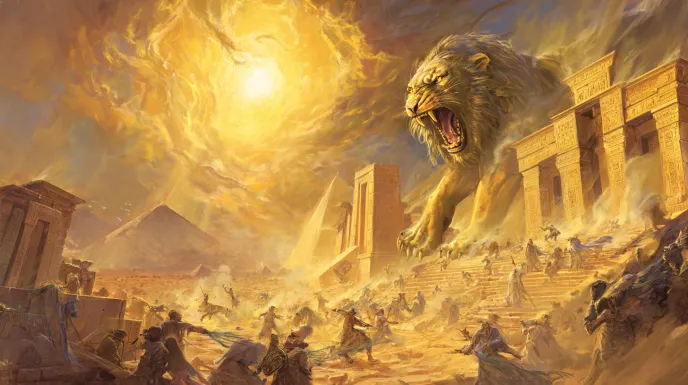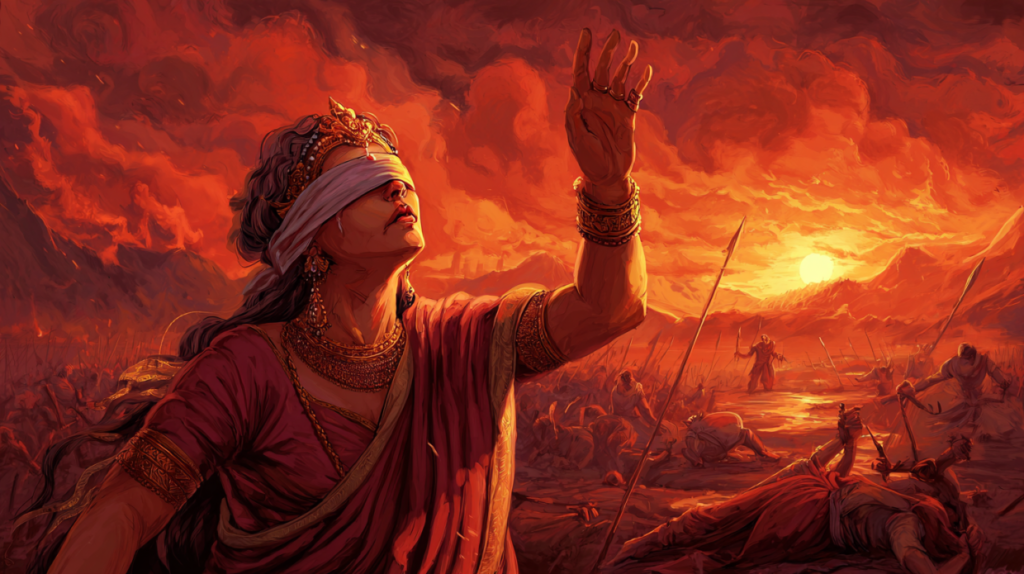Boons and curses in mythology are not just magical plot devices—they are cosmic forces that forge destinies, topple empires, and birth avatars. Picture a blindfolded queen standing amidst a battlefield’s carnage, cursing a god with every ounce of her grief. Elsewhere, a demon king revels in a divine boon of near-immortality, unaware of the ferocious half-lion avatar waiting to exploit its loopholes. In another land, a king’s ecstatic wish for limitless gold turns his life to cold metal despair. Across cultures and centuries, these divine blessings and punishments have been twin blades—granting power while sealing doom, shaping the mythic histories we still tell today.
In mythic lore, being blessed by the gods or cursed by the gods is never simple. A boon might grant power or prosperity, yet carry unintended consequences; a curse might spell doom, yet fulfill a larger cosmic plan. These stories, from the Mahabharata war to Greek legends and even fairy tales, all echo the ancient warning: be careful what you wish for. In this storytelling journey, we explore how divine boons and banes have shaped destinies—highlighting the emotional drama, ethical dilemmas, and unintended fallout that make these myths eternally resonant.
Boons and Curses in Mythology: A Universal Motif
Mythologies worldwide share a fascination with divine interventions. Gods reward the devout with miraculous boons, and punish the arrogant with dire curses, but often the line between blessing and curse blurs. From Hindu epics to Greek myths, Norse sagas to biblical tales, boons and curses in mythology serve as plot engines and moral lessons. They demonstrate how desire and destiny intersect in unpredictable ways. A granted wish might backfire disastrously, while a curse, ironically, might set the stage for heroic deeds or necessary endings. This duality speaks to a universal truth: every gift has a price, and every curse a purpose.
Below, we delve into some of the most powerful examples—tales where divine boons or curses dramatically altered the fate of individuals, families, and even entire ages.
Gandhari’s Curse on Krishna – A Mother’s Grief Alters Destiny

One of the most poignant curses in Hindu mythology occurs at the end of the Mahabharata war. Queen Gandhari, mother of a hundred sons (the Kauravas), is shattered by the slaughter of her children. In her anguish, she turns her wrath on Krishna, who had guided the opposing Pandavas. Despite knowing Krishna’s divine nature, Gandhari cannot forgive his role in the war’s carnage. With tearful fury, she curses him: in 36 years, his proud clan will destroy itself and he will die alone, struck down helplessly.
This curse, born from a mother’s grief, plays out exactly as foretold. Years later, the Yadava tribe (Krishna’s people) falls into drunken infighting, eventually annihilating themselves while Krishna watches in sorrow. The once-invincible Lord accepts this fate as the destined end of his earthly mission. True to Gandhari’s words, Krishna retreats to the forest, where a hunter’s stray arrow strikes him, bringing about Krishna’s departure from the world . Gandhari’s curse thus not only ends a dynasty but also marks the close of the Dvapara Yuga (epoch), ushering in Kali Yuga.
Emotionally, this story is heartrending. Gandhari’s agonizing “why?” to Krishna reflects the devastation of war and the vulnerability even gods face before a devotee’s curse. Ethically, it raises questions: Krishna, though divine, chose not to prevent the war—was the curse a just karmic consequence? The Mahabharata presents it as a moment of profound tragedy and cosmic balance. A boon (Krishna’s protection of the Pandavas) had ensured victory in war, but a curse ensured even the victors’ divine ally paid a price. The duality of boons and curses in mythology is stark here: one mother’s blessing saved the Pandavas earlier, and one mother’s curse doomed their savior later. This tale emphasizes that no one, not even a god, escapes the ripple effects of loss and fate.(Internal Link Suggestion: For more on this epic climax, see our article on Krishna’s departure and the aftermath of the Mahabharata war.)
Hiranyakashipu’s Boon of Invincibility – When Power Becomes a Trap

If Gandhari’s curse exemplifies sorrow turned to destiny, the tale of Hiranyakashipu illustrates how an overly generous boon can become a bane. Hiranyakashipu was an asura (demon) king who sought revenge against Vishnu for slaying his brother. Through extreme penance, he won a boon from Brahma that he believed made him virtually immortal. Since Brahma could not grant immortality outright, Hiranyakashipu crafted an elaborate wish: no man or animal could kill him, neither indoors nor outdoors, neither during day nor night, neither on earth nor in the air, and no weapon would harm him. Brahma granted this clever boon, and indeed it seemed no creature in the universe could slay Hiranyakashipu. Empowered by this blessing, the demon king unleashed terror, proclaiming himself God and persecuting those who worshipped Vishnu – including his own virtuous son, Prahlada.
However, this triumphant boon had an expiration written in its clauses. To protect Prahlada and end Hiranyakashipu’s tyranny, Vishnu incarnated as Narasimha – a ferocious half-man, half-lion avatar. This form was neither man nor animal, perfectly exploiting the boon’s loophole. At dusk (neither day nor night), on a threshold (neither indoors nor outdoors), Narasimha set the asura on his lap (neither ground nor air) and tore him apart with claws (no weapon). Thus the Narasimha avatar fulfilled the letter of Brahma’s boon while utterly defeating its spirit. The very protections Hiranyakashipu demanded became the parameters of his demise!
This dramatic story from the Puranas shows a boon turning into a death trap. Hiranyakashipu’s arrogant wish for invincibility blinded him to the fine print—demonstrating that in mythology, great boons often carry the seeds of great downfall. The unintended consequence here was literal: a monster of his own making. Emotionally, the narrative swings from Hiranyakashipu’s hubris to the awe and terror of divine retribution. Ethically, one might read it as a lesson against overreaching ambition and the folly of outsmarting the cosmic order. The boon that made Hiranyakashipu fearless also made him careless, and the curse of his own cruelty returned to him in the form of Narasimha’s claws.(Internal Link Suggestion: Read more about the Narasimha avatar, the savior of Prahlada and vanquisher of Hiranyakashipu, in our related article.)
King Midas’s Golden Touch – A Blessing That Became a Curse

Moving to Greek mythology, we find the classic cautionary tale of King Midas. Whereas Hiranyakashipu’s boon was carefully calculated, Midas’s wish was impulsive and born of greed. After treating the god Dionysus’s companion kindly, Midas was granted any reward he chose. The king eagerly wished that everything he touched turn to gold. At first, this boon seemed glorious—flowers, stones, and furnishings glittered at his mere touch. Midas rejoiced in his new power, reveling in the wealth literally at his fingertips.
However, the shine of this boon quickly dulled. When Midas sat to dine, his food and drink transformed into solid gold, inedible and lifeless. According to legend, even his beloved daughter, upon rushing to embrace him, was turned into a golden statue in his arms. In that devastating moment, King Midas realized his gift was truly a curse. His prayer for wealth had brought only loneliness and starvation. As an ancient writer noted, “he understood that this gift was a bane and in his loathing for gold, cursed his prayer.” Dionysus took pity on the wretched king and allowed him to wash away the golden touch, but not before Midas learned a bitter lesson.
The story of Midas encapsulates the “be careful what you wish for” motif perfectly. Emotionally, we feel the king’s initial euphoria turn to despair—an intense swing that underscores how quickly fortune can turn. Narratively, the boon that becomes a bane is a powerful device: Midas’s own hands become instruments of tragedy. Ethically, the tale criticizes greed and literal-minded wishing. Midas asked for limitless wealth without considering the human needs of life and love; in return, he nearly lost both. Among boons and curses in mythology, Midas’s golden touch stands out as a reminder that unchecked desire can itself be a curse. The unintended consequences in this myth are glaring and immediate, making it one of the most enduring morality tales from antiquity.
“Be Careful What You Wish For” – Echoes in Biblical and Folk Tales
The dual nature of boons and curses isn’t confined to formal mythology—it echoes through religious lore and folk tales as well. In the Bible, one finds cautionary stories about prayers answered with unexpected results. Consider King Hezekiah of Judah: when terminally ill, he begged God for a longer life. God granted this boon, extending Hezekiah’s life by 15 years. Sounds purely blessed, right? Yet during those added years, Hezekiah fathered Manasseh, who became one of the most infamously wicked kings, leading his people into idolatry and bloodshed. Some later commentators note that if Hezekiah’s life hadn’t been prolonged, Manasseh would never have been born to wreak such evil. In essence, an answered prayer sowed the seeds of tragedy for the next generation. As one analysis wryly concludes, “If Hezekiah hadn’t asked for healing, Manasseh would never have been born… be careful what you pray for!”. This biblical episode poses an ethical dilemma: Was the boon truly a blessing, or did it carry a hidden curse in the form of unforeseen consequences?

Folk literature is replete with the “be careful what you wish for” theme. A famous example is the short story “The Monkey’s Paw” (W. W. Jacobs, 1902), which might as well be a modern myth. In it, a mystical monkey’s paw is enchanted to grant three wishes—but each wish exacts a horrific price. An old fakir cursed the paw specifically so that any interference with fate via a wish would invoke “hellish consequences as punishment for tampering with fate.” Time and again, the characters’ wishes are granted in literal but twisted ways, bringing only grief and terror. The monkey’s paw tale is essentially a horror retelling of an age-old truth: a cursed boon can be more dangerous than no boon at all.
Even children’s fairy tales carry this motif. How many stories tell of a foolish individual granted three wishes, only to squander them and end worse off than before? From genies in lamps who twist their masters’ words, to deals with the Devil that backfire, the message resonates: wishing unwisely can invite a curse. These narratives, while simpler, reinforce the same lesson as the grand myths — that unexamined desires often lead to regret.
In all these tales, whether sacred or popular, a pattern emerges. Divine or magical gifts come with strings attached, and curses sometimes lurk behind kindly smiles. It’s a narrative pattern that speaks to human nature: we are often the architects of our own misfortune when driven by shortsighted desires.
(Explore our deep-dive on fate and free will in mythic stories for more instances where mortal wishes and divine will collide.)
Norse and Egyptian Myths – Cursed Treasures and Divine Retribution

The theme of fatal blessings and redemptive curses spans even further. In Norse mythology, one striking example is the tale of Andvari’s ring. Andvari was a dwarf who owned a magical ring named Andvaranaut that helped him amass a great hoard of gold. When the trickster god Loki extorted this treasure, Andvari laid a curse upon the gold and the ring—that it would destroy anyone who possessed them.
The curse came to pass spectacularly: the treasure sowed greed and murder in a royal family. The dwarf’s ring brought ruin to Fafnir, who killed his own father for it and transformed into a dragon to guard the gold, only to be slain by the hero Sigurd. The same cursed wealth caused betrayal and tragedy down the line. Here, a stolen boon of wealth carried a built-in bane: whoever holds this treasure shall come to a terrible end. This legend not only inspired Wagner’s opera cycle and Tolkien’s fiction, but it also illustrates a key mythic idea: greed turns blessings into curses. A treasure dearly won becomes a source of destruction — a clear “be careful what you wish for” warning from the Viking age.
In Egyptian lore, we likewise find curses entwined with boons. Ancient Egyptians deeply feared tomb curses — warnings that the mummy’s spirit or the gods would punish those who disturbed a pharaoh’s rest. The famous “curse of the pharaohs” (though mostly modern legend) exemplifies how strongly people believed a boon of eternal afterlife was protected by potent curses. But beyond tombs, Egyptian mythology proper gives us a dramatic example in the story of Sekhmet.
The sun god Ra, angered by humanity’s sins, unleashed the lioness goddess Sekhmet as a boon of divine retribution. Sekhmet’s rampage was meant to cleanse evil, but it nearly wiped out all humanity in an out-of-control bloodlust. The gods had to scramble to stop her—Ra ultimately tricked Sekhmet into drinking beer dyed red like blood to subdue her fury. In this tale, a divine blessing of vengeance quickly turned into a curse upon the world, barely averted by intervention. It’s a stark reminder that even the gods had to be careful with the powers they set in motion.
Whether it’s a cursed treasure in the Norse sagas or a wrathful deity in Egyptian myth, the motif is consistent. A gift intended for justice or prosperity can escalate beyond anyone’s intent, and a curse, once uttered, takes on a life of its own. These myths underscore the delicate balance in the cosmic order—tilt it with a wish or a wrathful word, and the scales may swing wildly. The unintended consequences become tales of caution that have survived millennia.
Unintended Consequences and Ethical Dilemmas

Why are we so captivated by these stories of boons and curses shaping destiny? Perhaps because they dramatize a core human truth: every choice and blessing comes with consequences. The myths force characters—and us—to confront the ethical dimensions of desire and power. When a boon is granted, the ethical dilemma often becomes, “At what cost?” When a curse is cast, we ask, “Does the punishment fit, or does it serve a higher purpose?”
In many of these tales, there is an implicit moral calculus. Gandhari’s curse, born of righteous grief, aligns with the cosmic need for the Yadavas’ pride to be checked; Hiranyakashipu’s boon, won through devotion but used for evil, necessitates a fierce correction. The motif of “be careful what you wish for” speaks to the responsibility that comes with free will. The characters who suffer from their boons (like Midas or Hezekiah) often asked out of selfishness or shortsightedness. Those harmed by curses (like Krishna, or victims of cursed treasures) often find those curses intertwined with destiny or hubris that needed addressing.
These stories are emotionally engaging because they don’t deal in black-and-white rewards or punishments. Instead, they live in the morally gray area of unintended consequences. We empathize with Gandhari’s heartbreak even as we lament the destruction of Krishna’s clan. We sympathize with Midas’s regret despite knowing his greed caused it. We see the justice in Narasimha’s violence while shuddering at its gore. This complexity makes the tales feel profound and relatable. In life, too, what we fervently wish for might not bring the happiness we expect, and what seems like a curse might carry a hidden blessing in time.
From an analytical lens, boons and curses in mythology often serve as narrative devices to propel events that otherwise wouldn’t happen. They allow epic plot twists—wars ending, dynasties falling, monsters rising—that hinge on a single moment of divine intervention. But they also serve as teaching tools, preserving cultural values. Indian epics highlight dharma (duty and moral order) by showing how bending it invites curse or how divine grace can be misused. Greek myths warn against hubris (excessive pride) by literally turning prideful wishes into personal curses. Norse legends emphasize the inevitability of fate (even gods can’t escape prophecies and curses), while fairy tales distill these lessons for the young with simpler analogies.
Ultimately, the dual theme of boon and bane asks us to reflect on our own ethics and desires. If offered a wish, would we think it through? If wronged, would we lay a curse or show mercy? The myths suggest that the gods’ favor is fickle and their wrath is precise—so mortals must navigate life with humility and wisdom. “Blessed by the gods” and “cursed by the gods” are two sides of the same cosmic coin. To flip that coin carelessly is to risk losing everything.
Conclusion
Mythic history, whether in the pages of scripture or the whispers of folklore, has been shaped as much by boons as by banes. These tales endure because they combine thrilling drama with deep moral insight. A simple blessing can unravel into tragedy, and a curse can fulfill a divine plan. Through storytelling alchemy, ancient narrators turned these extremes into lessons that still resonate. We cheer and we cry because somewhere in these fantastical events we recognize truths about our own lives—about greed and gratitude, anger and forgiveness, fate and free will.
“Cursed by the gods, blessed by the gods” is more than a catchy phrase; it’s a recognition that every powerful gift carries risk, and every hardship may hide a blessing. As seen in these myths, the boons and curses in mythology were the catalysts for epic wars, heroic sacrifices, the rise and fall of kings, and the transformation of ages. They remind us that in the grand tapestry of fate, the gods’ role is often to grant what is asked (or deserved) and let the drama unfold.
By examining these stories, we don’t just entertain the imagination—we also inherit the wisdom of our ancestors. Their message is clear: be careful what you wish for, be mindful of how you act, for the forces of the universe may answer in wondrous or devastating ways. In the end, the tales of blessings and curses urge a balance between aspiration and caution, teaching that true wisdom lies in understanding the consequences. And that lesson, forged in the fires of myth, is as relevant now as ever.
FAQ
Q1: Why do so many myths revolve around boons and curses?
A: Boons and curses are dramatic devices that drive the plot of many myths while conveying moral lessons. They externalize the idea of cause and effect or karma—good deeds might attract divine blessings, and misdeeds or hubris invite curses. These elements also allow storytellers to explore the limits of human desire and the justice of the gods. In essence, boons and curses make the stakes in mythology intensely high, demonstrating how a single wish or wrathful utterance can change the course of history.
Q2: What does the motif “be careful what you wish for” mean in mythology?
A: “Be careful what you wish for” is a common theme meaning that a desire fulfilled might have unintended consequences. Mythology uses this motif to warn that people often ask for things without foresight. For example, King Midas wished for unlimited wealth and was cursed by that very wish when it nearly starved him and cost him his daughter. The idea is that one’s wishes or boons can backfire if they are driven by greed, pride, or short-sightedness. Myths across cultures—from fairy tales like The Monkey’s Paw to divine boons in epics—echo this cautionary theme.
Q3: How did Gandhari’s curse affect Lord Krishna?
A: In the Mahabharata, Queen Gandhari’s curse had a profound effect on Lord Krishna. She cursed him in her grief, declaring that 36 years hence, his Yadava clan would annihilate itself and Krishna too would perish tragically. This indeed came to pass: internal strife led the Yadavas to a drunken brawl where they killed each other, and soon after, Krishna was hit by a hunter’s arrow and left his mortal body. Essentially, Gandhari’s curse orchestrated the end of Krishna’s dynasty and marked Krishna’s departure from the world, fulfilling his destiny and ending that chapter of the epic.
Q4: How did Hiranyakashipu’s boon lead to his death?
A: Hiranyakashipu’s boon was meant to prevent his death, but it ironically set the terms for it. He obtained a boon from Brahma with numerous conditions to avoid death by any conventional means (no human or animal, weapon, day or night, etc.). However, Lord Vishnu incarnated as Narasimha (half-man, half-lion) and killed Hiranyakashipu at twilight, on a doorstep, using his clawsen.wikipedia.org. These circumstances bypassed every clause of the boon. Thus, the very boon of invulnerability lulled Hiranyakashipu into arrogance and complacency, and Vishnu exploited its loopholes. It’s a prime example of a boon turning into a bane – his wish was granted literally, but not in the way he expected, leading to his demise.
Q5: Do curses in mythology always come true?
A: In many myths, curses do come true, but sometimes not in the way one might anticipate. Myths often have a strong theme of fate or destiny, so a pronounced curse sets a narrative in motion that usually reaches its fulfillment (as with Gandhari’s curse on Krishna or the curse on Andvari’s ring in Norse myth). However, there are cases where clever heroes find ways to mitigate or break curses (for instance, by atoning or seeking divine help). Curses in mythology symbolize the inescapability of fate—once uttered by a powerful being (god, sage, etc.), they tend to manifest one way or another. This inevitability makes curses a powerful storytelling tool and underscores the belief that no one can easily escape the cosmic law of cause and effect.
References (External Sources)
- Bryant, Kevin. “Gandhari – Mother of the Kauravas.” Wikipedia (Stri Parva summary of curse)en.wikipedia.org.
- TOI Lifestyle Desk. “Why was Shri Krishna killed by a hunter?” Times of India (Gandhari’s curse on Krishna) timesofindia.indiatimes.comtimesofindia.indiatimes.com.
- Bhagavata Purana / Vishnu Purana – Legend of Hiranyakashipu and Narasimha (translated in Wikipedia) en.wikipedia.org.
- Claudian (Late Antique poet). In Rufinum (referenced in Midas story) – as cited by Wikipedia (Midas realizes his golden touch is a curse) en.wikipedia.org.
- W. W. Jacobs. The Monkey’s Paw (1902) – Plot summary via Wikipedia (wishes granted with hellish consequences) en.wikipedia.org.
- “The Curse of Andvari’s Ring.” The Warrior Lodge (Norse mythology blog) – Andvari’s ring curse on gold hoard thewarriorlodge.com.
- Guzik, David. Bible Commentary on 2 Kings 20 / Isaiah 38 – (King Hezekiah’s extended life and Manasseh’s birth)

